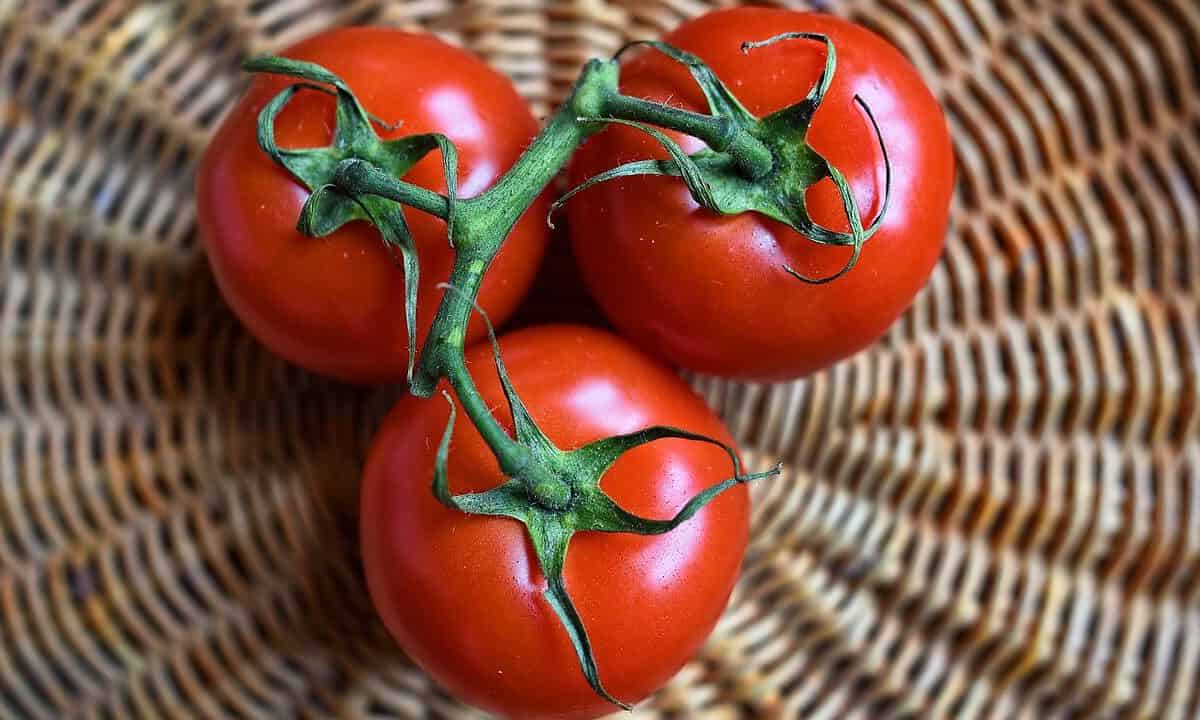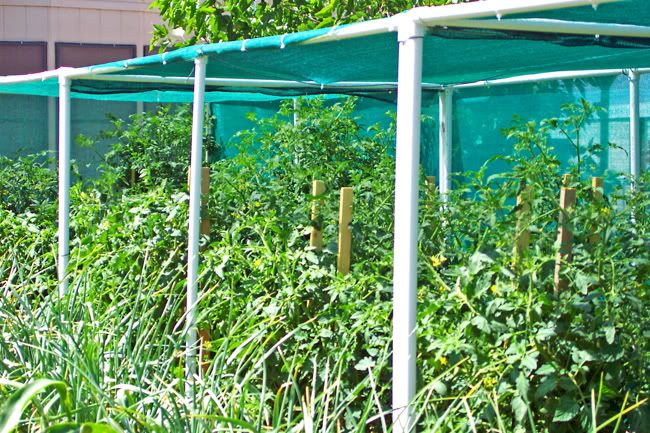When summer heat arrives, tomato plants need protection from intense sun and scorching temperatures. While tomatoes require full sun to grow and fruit well too much direct sunlight can actually harm plants once the weather turns hot.
Using shade structures fabrics or other methods to provide a respite from the harshest rays will allow tomato plants to thrive through midsummer. Read on to learn more about when and how to implement sun shade solutions for your tomato crop.
Why Tomato Plants Need Sun Protection in Summer
Tomato plants revel in full sun during cooler seasons when they are actively growing and setting fruit. But once temperatures climb above 85°F or so, problems can occur. Issues tomato plants may face include:
- Sunscald – White, blistered areas on fruit from direct sun exposure
- Sunburn – Wilting, dry, damaged foliage
- Blossom drop – Heat prevents pollination and fruit set
- Poor development – High temps inhibit fruit color and flavor
- Slowed growth – Heat stress halts vigorous plant processes
Implementing some shade and sunlight filtering allows tomatoes to avoid these issues during summer’s hottest stretches.
When to Provide Shade Coverings
The time to set up sun barriers for tomato plants is typically
-
When daytime temperatures consistently reach 85°F – 90°F
-
When night temperatures stay above 75°F
-
During peak sun hours from around 11am – 3pm
-
When fruit shows signs of sunscald like white patches
Adjust and remove shade structures as needed based on weather patterns and plant condition in your garden.
Making Shade Structures for Tomato Plants
There are many creative options for providing shade cover for tomatoes during hot spells:
Row Covers
These fabric covers allow airflow and filter sunlight. Use summer-weight row cover that provides 30% to 50% shade. Drape directly over plants or hoop support frames.
Shade Cloth
Specially designed shade cloth can be purchased based on the percentage of shade needed. 50% to 80% shade is ideal. Cut pieces to size and securely attach to tomato cages, poles, or frames.
Old Sheets or Burlap
Lightweight household fabrics like sheets or curtains can be fashioned into moveable shade covers. Drape them over cages or clothesline-style supports above beds.
Umbrellas
Use patio, beach, or garden umbrellas to provide isolated shade for a few container tomatoes. Stake them into soil or weigh base down for security.
Trees or Structures
Take advantage of existing shade sources like trees, buildings, and fences. Plant tomatoes near east or north facing walls or under deciduous trees.
Arbors and Trellises
Install open overhead structures in the garden to support vines while offering midday shade. Position them to block western sun.
With a little creativity, it’s easy to construct effective shade solutions to protect tomato plants using materials around your home and garden.
Tips for Maximizing the Benefits of Shade
When setting up shade for tomato plants, keep these tips in mind:
-
Make sure plants receive morning sun for growth and fruiting. Block intense afternoon sun.
-
Allow for air circulation under and around shade covers to prevent disease.
-
Use shade cloth rated for at least 50% sun blockage, or greater if very hot.
-
Check plants daily and adjust shade as needed based on conditions.
-
Remove covers when extreme heat has passed to allow plants to continue ripening.
-
Provide extra water for shaded plants to prevent drought stress.
-
Stake up sprawling vines so they stay under the protected area.
With strategic shading, tomato plants can thrive even during summer’s dog days. Make adjustments as needed to find the right balance in your garden.
Other Warm Weather Care Tips
In addition to providing shade structures, some other ways to help tomato plants handle heat waves include:
-
Mulching beds to keep roots cool and moist
-
Watering in morning so foliage dries faster in sun
-
Choosing heat tolerant varieties like Celebrity, Heatmaster, and Solar Fire
-
Spraying plants with water to create a cooling evaporative effect
-
Ventilating greenhouses or tunnels to prevent overheating
-
Monitoring soil moisture closely and watering consistently
-
Avoiding high nitrogen fertilizers which make plants prone to sun damage
-
Picking ripe tomatoes promptly to prevent fruits from overheating
Proper shade paired with attentive care helps tomatoes thrive through summer’s sweltering temperatures. Adjust your practices as the weather shifts.
Signs Your Tomato Plants Need More Shade
Monitor your tomato plants closely for signals they require relief from excessive light and heat:
-
Wilting, drooping, or curled foliage
-
Leaves or stems appearing dried or scorched
-
White blistered patches on developing green fruits
-
Lackluster growth and reduced flowering/fruiting
-
Failure of fruit to ripen from green to red
-
Smaller fruit size or catfaced tomatoes
When you spot these issues, it’s time to add shade structures to buffer plants from harsh direct sun.
Troubleshooting Tomato Shade Solutions
If your shading methods for tomatoes aren’t having the desired effect, try these troubleshooting tips:
Plants still showing heat stress – Use shade material that blocks more sun, up to 80% if very hot. Or double up layers of lightweight covers.
Leaves turning pale or yellow – Increase sunlight exposure gradually in early morning or late afternoon if plants show signs of insufficient light for photosynthesis.
Diseases developing – Improve airflow around plants by removing covers partially or using mesh shade fabric. Water at base of plants rather than overhead.
Fruits slow to ripen – Remove shade structures in early morning or evening to allow more sun exposure for ripening.
Storm damage – Use sturdy stakes, poles, or frames and check covers daily to prevent billowing or tearing of shade materials during wind and rain.
Cats lounging in covered beds – Discourage feline nappers by placing attractivebranches or garden ornaments in shaded areas.
With a little vigilance and adjustments when needed, your tomato shade structures should provide the right balance of sun protection and growing conditions for thriving plants.
Enjoying the Benefits of Shaded Tomato Plants
Providing the right amount and type of shade enables tomato plants to produce their best, even during hot and sunny summers. With reduced risk of sunscald, blossom drop, and other issues, your tomatoes will keep growing vigorously and churning out ripe, beautiful fruits.
Shade covers also make spending time tending the vegetable garden muc
When to shade tomatoes?
Summer is the best time to shade your tomatoes.
According to research, shading that reduced daily integrated solar radiation to 5-6 MJ.m(-2) effectively increased marketable fruit yields when the air temperature exceeded 25 degrees C.
What percent of shade cloth for tomatoes?
When growing tomatoes, it can be hard to find the right balance between giving them enough sun and keeping your plants from getting too much.
If your tomatoes are in the sun for too long, they may get burned or blistered, which will ruin their taste and look.
So what is the best shade rate for tomatoes?
The answer is that the most suitable shade percentage for tomatoes is 30 to 50%.
The best way to protect your tomato plants from the sun while still letting them get enough light is to choose the right percentage of shade cloth.
A study done by Gent showed that total yield decreased with increasing shade (15%,30%, 50%), but there was no effect of shade on the yield of marketable fruit. The fraction of marketable fruit was greatest for plants grown under 50% shade. Cracked skin was the most affected fruit defect by shade; up to 35% of the tomatoes produced in greenhouses without shade had cracked skin, whereas, in greenhouses covered with 50% shade, only 25% to 29% of the tomatoes had cracked skin.
Liu’s study showed that tomatoes could grow well and produce higher yields if some moderate shading (40% shading) was applied at the LF stage in summer midday.
Another study from Texas indicated that shading tomato plants at 50% shade reduced heat stress, whereas a lower percentage of shade was better.
You need to pick the right shade cloth for your needs because they give off different amounts of shade.
So, A shading rate of 30-50 will have a beneficial effect on your tomato growth.

In the previous section, we answered the question about the correct shading rate for tomatoes.
In this article, we’ll talk about more ways to deal with the problem of shade when growing tomatoes.
My SECRET WEAPON For Gardening In EXTREME Heat And Sun
FAQ
How to shade your tomato plants?
Is 50% shade cloth too much for tomatoes?
What sun is best for tomato plants?
Do tomatoes grow in shade?
Technically, tomatoes are full sun plants not known to produce fruits in the shade. They require full sunlight for higher rates of photosynthesis to ensure the plant has enough energy to produce large fruits. The term shade-tolerant-tomato is a slight misnomer.
What is a shade tolerant tomato?
Shade-tolerant tomatoes are those varieties that will still produce some fruit when not planted in the desired six hours of direct light per day. They may have smaller fruits to produce, as with cherry tomato varieties, or have shorter maturing periods that allow the plant to adapt better to lower light levels.
What is a shade tomato?
Shade tomatoes are a unique variety of tomato that has been bred to thrive in areas with less sunlight than traditional tomato varieties require. These plants are becoming increasingly popular as they allow growers to cultivate tomatoes in areas that were previously unsuitable due to a lack of sunlight.
Do tomato plants need full sun?
Tomatoes typically thrive in full sun, with at least 6 to 8 hours of direct sunlight per day. So what if you want to grow tomatoes but you don’t have a fully sunny location? Any tomato plant will prefer full sun, but the good news for gardeners with shady plots is that there are some tomato varieties that will tolerate a bit of shade.
- The Ultimate Guide to Growing Strawberries in Raised Beds - August 8, 2025
- No-Dig Garden Beds: The Easiest Way to Grow a Beautiful Garden - August 6, 2025
- How to Protect and Preserve Wood for Raised Garden Beds - August 6, 2025

